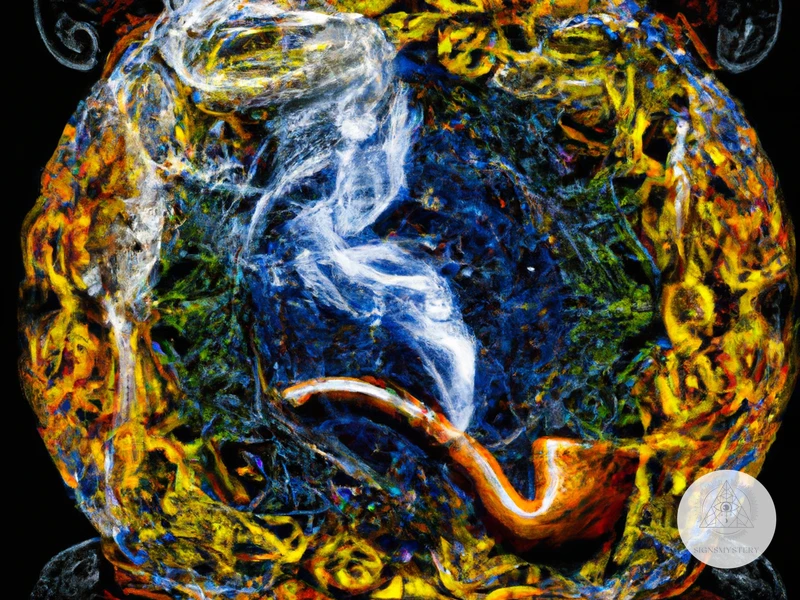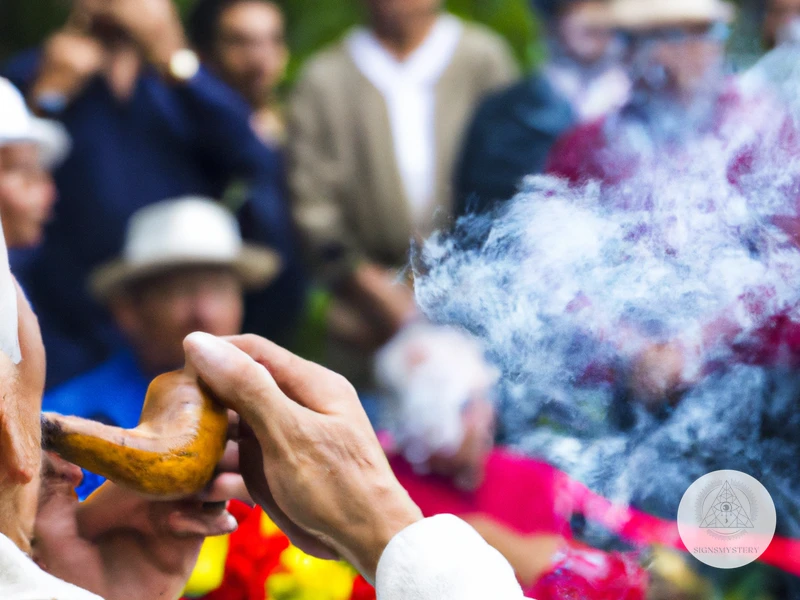Tobacco has been an integral part of indigenous cultures and shamanic practices for centuries. Yet, the spiritual significance of tobacco can still be shrouded in mystery and misconceptions in modern times. In this article, we will explore the history of tobacco use in indigenous cultures, its role in shamanism, and the traditions of tobacco ceremonies. We’ll also address controversies and misconceptions surrounding tobacco, such as its negative effects in commercialized forms and its misunderstanding as a hallucinogenic substance. Join us as we delve into the captivating world of the spiritual significance of tobacco in indigenous cultures and shamanic rituals.
The History of Tobacco Use in Indigenous Cultures

Tobacco has long been a sacred plant in many indigenous cultures and has been used for various spiritual and medicinal purposes. In indigenous mythology and folklore, tobacco is often associated with creation myths and is believed to have been gifted to humans by the spirits. Tobacco is also used in healing practices, where it is used to treat ailments ranging from headaches to toothaches. In spiritual practices, tobacco is used for offerings, purification, and communication with spirits. Despite the controversy surrounding tobacco use, its significance in indigenous cultures cannot be ignored. If you’re interested in learning more about the use of various plant medicines in shamanic practices, check out this article.
Tobacco in Mythology and Folklore
Tobacco has been an important plant in the spiritual traditions of indigenous cultures for centuries. Its use in mythologies and folklore is widespread among many different communities. For example:
| Community | Mythology/Folklore |
|---|---|
| Cherokee | According to one legend, the first tobacco plant sprouted from the grave of a woman who had been killed by her husband. The plant was considered a gift from the woman’s spirit, and its smoke was thought to carry her messages to the living. |
| Arawak | The Arawak people of South America believed that tobacco was a gift from their creator god, who had taught them how to use it for healing and communication with spirits. |
| Hopi | The Hopi people of North America believed that tobacco was a sacred plant that could help them connect with their ancestors and the spirits of the natural world. They would use tobacco in their prayers and rituals, and even offer it to the spirits as a sign of respect. |
In many indigenous cultures, tobacco is seen as a bridge between the physical world and the spiritual realm. It is believed that when tobacco is burned, its smoke carries prayers and messages to the spirits. In this way, tobacco is considered a powerful tool for communication and connection with the divine.
It is important to note that the recreational use of tobacco is not the same as its use in indigenous spiritual traditions. The former often involves harmful additives and chemicals, whereas the latter involves the careful cultivation and use of natural tobacco plants in a sacred context. To understand the true spiritual significance of tobacco, it is important to recognize and respect its role in indigenous cultures.
Tobacco in Healing and Medicinal Practices
Tobacco has long been used in indigenous cultures for its medicinal properties. When applied correctly, tobacco can have a range of medicinal benefits, including pain relief, wound healing, and respiratory support.
Here are some examples of how tobacco has been used in healing and medicinal practices in Indigenous cultures:
| Culture/Tradition | Healing/Medicinal Use of Tobacco |
|---|---|
| Cherokee | The Cherokee people used tobacco in a variety of medicinal ways, including the treatment of earaches, toothaches, and sore throats. They also used tobacco as a poultice to treat wounds and bruises. |
| Hopi | The Hopi people used a powdered form of tobacco as a remedy for headaches and as a general pain reliever. They also used tobacco smoke for respiratory support and to ease congestion. |
| Mexica (Aztec) | The Mexica people used tobacco as a treatment for snakebites and scorpion stings. They also believed that tobacco smoke had purifying effects and could be used to cleanse the body and mind. |
| Taino | The Taino people used tobacco as a remedy for various ailments, including asthma and bronchitis. They also used tobacco in combination with other herbs to create a medicinal tea. |
It is important to note that the medicinal use of tobacco in indigenous cultures is very different from the recreational use of tobacco in modern Western society. Recreational use of tobacco products can be harmful to one’s health and is not recommended.
If you are interested in exploring other plant medicines used in shamanic practices, you may want to consider researching ayahuasca, psilocybin mushrooms, iboga, San Pedro cactus, salvia, peyote, and cannabis. While these substances are not without risks, many people believe that they have transformative healing potential. Comparing and contrasting the uses and effects of these plants can be a fascinating study in its own right.
Tobacco in Purification and Spiritual Practices
The use of tobacco in purification and spiritual practices is a common tradition in many indigenous cultures. It is considered a powerful tool for cleansing and protection of the spirit, mind, and body. Here are some examples of how tobacco is used in purification and spiritual practices:
| Tobacco Practice | Culture |
|---|---|
| Tobacco Smoke Bath | In the Lakota tradition, the tobacco smoke bath is used for purification before spiritual ceremonies. It involves sitting in a small, enclosed space filled with the smoke of burning tobacco. The smoke is absorbed into the body and helps to release negative energy. |
| Tobacco Prayer Ties | In the Navajo tradition, tobacco prayer ties are made by wrapping tobacco in cloth and tying it into a bundle. The cloth is then tied to a sacred object or placed on an altar as an offering to the spirits. The act of making and offering the tobacco prayer tie is a form of purification. |
| Tobacco Baths | The Kaxinawá people of the Amazon use tobacco in their spiritual baths, which are taken for spiritual cleansing and protection. The tobacco is soaked in water overnight, then the water is used to bathe the body. It is believed to help remove negative energy and restore balance. |
It’s important to note that the tobacco used in these practices is typically grown and harvested specifically for spiritual use, and is not the same as commercial tobacco products. The spiritual use of tobacco should not be confused with the harmful effects of smoking commercial tobacco.
The use of tobacco in purification and spiritual practices is a long-standing tradition in many indigenous cultures. It is considered a powerful tool for cleansing and protection of the spirit, mind, and body. However, it’s essential to understand that the tobacco used in these practices is not the same as commercial tobacco, and the health risks of smoking commercial tobacco cannot be ignored.
The Role of Tobacco in Shamanism
Tobacco has an important role in shamanism, being considered a “sacred plant” by many indigenous cultures. Its use during shamanic practices is not only limited to smoking, but also to other forms of consumption and interaction with the spirit world. Tobacco is believed to have a protective effect, guiding the shaman through the different stages of their journey and allowing them to communicate with other beings beyond our physical realm of existence. In tobacco shamanism, the plant is seen as a teacher, a guide, and a means for establishing boundaries with spirits. It is different from the harmful commercial tobacco, and it should not be confused with hallucinogenic substances. Instead, tobacco is used as a tool for connecting with the spiritual world, harnessing its benefits in a respectful and reverent way. If you are interested in learning more about how tobacco is used in shamanism and how it compares to other plant medicines used in this context, check out our article on Plant Medicines in Shamanic Comparison.
Tobacco in Shamanic Journeys and Vision Quests
Shamanic journeys and vision quests are central practices in many indigenous cultures. These practices are used to connect with the spiritual world, receive guidance and wisdom, and heal oneself and others.
Tobacco has been traditionally used as an important tool in shamanic journeys and vision quests. It is believed to have a powerful ability to open spiritual channels and facilitate communication with the spirit world. Shamans and healers use tobacco to enter altered states of consciousness, where they can connect with the divine and receive messages that can aid them in their work.
The use of tobacco in shamanic journeys and vision quests is not limited to smoking it. Chewing tobacco or macerating it in water or tea are also common practices. In some traditions, tobacco is mixed with other plants or substances to enhance its spiritual effects.
During shamanic journeys, tobacco is often offered to the spirits as a sign of respect and gratitude. It is also used to purify the space and protect the shaman and the participants from negative energy and entities.
In Vision quests, tobacco is used to help the participant connect with their spirit helpers and receive visions. Before the quest, the participant may be asked to undertake a tobacco fast. This involves abstaining from food and drink and consuming only tobacco for several days. The nicotine in tobacco is believed to help suppress hunger and thirst, making it easier for the participant to enter a trance state.
It is worth noting that the use of tobacco in shamanic journeys and vision quests should be approached with respect and caution. These practices are deeply spiritual and should only be undertaken by experienced and trained practitioners. Misuse or abuse of tobacco can have negative spiritual and physical consequences, and it is important to follow the traditional guidelines and rituals associated with its use.
Tobacco in Energy Cleansing and Protection
Tobacco has a profound role in spiritual practices related to energy cleansing and protection in many indigenous cultures. By burning tobacco leaves, the smoke produced is believed to have a powerful effect on the spiritual realm and can help to purify any negative energy that may be present.
There are several ways in which tobacco is used for energy cleansing and protection. Some of the most common methods are:
- Smudging: Smudging is a purification ritual that is used to clear negative energy from a space. It’s often used before or after a ceremony, or when moving into a new home. To smudge with tobacco, the leaves are burned and the smoke is fanned around the space with a feather or other tool. This is believed to clear out any negative energy and allow positive energy to flow.
- Aura cleansing: Tobacco can also be used to clean and protect the aura, which is the energetic field that surrounds the body. This is often done by blowing smoke over the body, which is believed to remove any negative energy that may be attached to the aura. This can be done during a shamanic ceremony or by an individual as a personal practice.
- Offerings: In some indigenous traditions, tobacco is considered to be a sacred plant that is used as an offering to the spirits. By offering tobacco, it’s believed that protection and blessings will be received in return.
It’s important to note that tobacco is not the only plant used for energy cleansing and protection in indigenous cultures. Sage, sweetgrass, and cedar are also commonly used for these purposes. However, tobacco holds a unique and powerful place in many traditions.
When using tobacco for energy cleansing and protection, it’s essential to do so with respect and intention. It’s important to understand the cultural significance of the plant and to use it in a way that is in alignment with traditional practices and beliefs.
Tobacco as a Communication Tool with Spirits
Indigenous cultures from around the world have long recognized tobacco as a powerful tool for communicating with the spiritual realm. In many shamanic traditions, the smoke from burning tobacco is believed to possess a sacred quality that can help open the channels of communication between human beings and the world of spirits.
For shamans and other spiritual practitioners, tobacco serves as a form of medicine that can be used to induce a trance-like state, which allows them to connect with the spirit world. The act of smoking tobacco can also serve as a form of prayer or offering to the spirits, inviting their presence and guidance in the practitioner’s life.
In many cultures, the tobacco plant itself is believed to have been a gift from the spirits. Some tribes even have creation myths that center around the tobacco plant and its importance in connecting humans with the divine.
However, it is important to note that not all tobacco use in spiritual practices is considered to be the same. For example, commercial cigarettes have been heavily criticized for their negative impact on health, and their use in spiritual practices has been met with significant controversy.
The use of tobacco as a communication tool with spirits is just one of the many ways in which indigenous cultures have recognized the profound spiritual significance of this powerful plant. While the practice may be controversial in some circles, it remains an integral part of many spiritual traditions to this day.
Tobacco Ceremony Traditions

Tobacco Ceremony Traditions have been an integral part of indigenous cultures for centuries. These ceremonies are used to connect with the spiritual world and create a sacred space for healing and communication. The sacred pipe ceremony is perhaps the most well-known tobacco ceremony, where participants gather in a circle and pass around a pipe filled with tobacco. The tobacco prayer is also an important tradition, where individuals offer tobacco to the spirits as a sign of respect and gratitude. The smoke offering involves burning tobacco and releasing the smoke, which is believed to carry prayers and intentions to the spirits. Finally, the tobacco bath is a powerful cleansing practice that involves bathing in tobacco-infused water to purify the body and mind. These tobacco ceremonies are deeply meaningful and profound experiences that continue to be practiced by indigenous cultures around the world.
The Sacred Pipe Ceremony
The Sacred Pipe Ceremony is a central tradition in many Indigenous cultures across North and South America. It is considered one of the most sacred and respected ceremonies in the Indigenous world, and is still practiced to this day. The pipe used in this ceremony is often called a “peace pipe” and is typically made from red pipestone or a similar material. Here are some key elements of the Sacred Pipe Ceremony:
– Purpose: The Sacred Pipe Ceremony is a powerful way to connect with the spiritual realm and seek guidance and protection from spirits. It is also used for healing and for offering thanks and appreciation to the Creator.
– Preparation: Before the ceremony, the pipe is typically cleansed and blessed with traditional herbs such as sage or cedar. Participants also prepare themselves through fasting, prayer, and purification rituals.
– Ceremony: During the ceremony, the pipe is often passed around in a clockwise direction, with each person taking a puff and then passing it to the next person. This symbolizes the interconnectedness of all things, and the sharing of blessings and prayers. The ceremony often includes singing, drumming, and other traditional rituals.
– Symbolism: The pipe itself is a powerful symbol in Indigenous cultures, representing the connection between the physical world and the spiritual world. The bowl of the pipe represents the earth, while the stem represents the human body and the smoke represents the spiritual realm.
– Respect: The Sacred Pipe Ceremony is a highly respected tradition and participants are expected to show reverence and respect at all times. This includes being mindful of one’s thoughts, actions, and words, and avoiding any behaviors that could be considered disrespectful or offensive.
The Sacred Pipe Ceremony is just one example of the deep spiritual significance that tobacco holds in Indigenous cultures. It is a powerful reminder of the importance of connecting with the spiritual realm and honoring the sacredness of all things.
The Tobacco Prayer
The Tobacco Prayer is a sacred and deeply spiritual practice that has been instilled in many Indigenous cultures for generations. It is a way of honoring the spirits, the Creator, and the Earth by offering tobacco as a gift and using it as a means of communication.
The prayer itself is a simple yet powerful ritual, consisting of offering tobacco, silently or aloud, while expressing gratitude and asking for guidance or blessings in return. The tobacco is seen as a conduit for communication with the spirits, and its smoke is believed to carry the messages and prayers to the heavens.
Here is an example of a traditional Tobacco Prayer:
| “Grandfather, I offer you this tobacco as a symbol of my gratitude and respect for all that you have given me. |
| May its smoke carry my prayers and intentions to you, and may you grant me the wisdom and clarity to walk the path of my purpose. Help me to live in harmony with all living things and to always remember the interconnectedness of all things. A’ho.” |
It is important to note that the Tobacco Prayer should only be performed with the utmost respect and reverence. It is not a casual or recreational practice, but rather a sacred and holy act. Tobacco should always be offered in moderation and never wasted, as it is a precious gift from the Earth and the spirits.
In some Indigenous
Subscribe to Our Newsletter
Sign up to receive the latest news and updates.
The Tobacco Prayer is a beautiful and profound way of connecting with the spiritual realm and honoring the sacredness of life. It reminds us to be grateful for all that we have been given and to live in harmony with the natural world.
The Smoke Offering
The Smoke Offering
The smoke offering is one of the most common tobacco ceremonies in Indigenous cultures. The smoke is believed to be a way of sending prayers and offerings to the world of spirits. The ceremony is usually performed using a sacred pipe or a bundle of dried herbs, which are burned using a flame. The smoke is then offered to the spirits, either by blowing it into the wind or by placing it on an altar.
In some cultures, the smoke offering is a way of asking for protection and guidance from the spirits. The smoke is believed to carry the prayers and intentions of the person performing the ceremony and to connect them with the spiritual realm. The person performing the ceremony may also use the smoke to cleanse their own energy and to release any negative or stagnant emotions.
The smoke offering ceremony is often performed in silence and with a deep sense of reverence. The smoke is considered to be sacred, and those participating in the ceremony are encouraged to approach it with humility and respect. In some traditions, the smoke may be accompanied by chanting or drumming, which can help to deepen the spiritual connection and to raise the energy of the ceremony.
The smoke offering is a powerful tool for spiritual connection and communication in Indigenous cultures. It is a way of showing respect and gratitude to the spirits, and of asking for their guidance and protection. As with all tobacco ceremonies, it is important to approach the smoke offering with an open heart and a willingness to learn and grow spiritually.
The Tobacco Bath
The Tobacco Bath, also known as the tobacco steam or tobacco sauna, is a traditional indigenous practice that involves inhaling the steam produced by hot water mixed with tobacco. The practice is believed to have originated among indigenous people in the Americas and has been used for its cleansing and healing properties.
During the tobacco bath, a pit is dug and filled with hot stones. Water mixed with tobacco leaves is then poured over the stones, producing a steam that is inhaled by the participant. The practice is usually done in a sweat lodge, a small dome-shaped structure covered with blankets or hides to retain the heat and steam.
The tobacco bath is often used for purification and cleansing, as the steam is believed to help release toxins from the body and clear the mind. It is also believed to have medicinal properties, as tobacco has been used traditionally as a pain reliever and anti-inflammatory agent.
The tobacco bath is considered a sacred ritual and is often performed as part of a larger ceremony or as a solitary practice. Participants may offer tobacco as a symbol of gratitude and respect for the healing powers of the practice.
It is important to note that the tobacco used in the bath is not the same as commercial tobacco that is found in cigarettes. Indigenous tobacco is often harvested and prepared in a ceremonial way, and is considered a sacred plant.
The use of the tobacco bath has faced controversy and criticism, as it has been misinterpreted as a form of drug use. However, its significance as a traditional indigenous practice should be respected and understood in its cultural context.
The tobacco bath serves as a reminder of the spiritual connection between indigenous people and the natural world. By practicing traditional rituals such as the tobacco bath, indigenous communities are able to maintain and preserve their cultural heritage.
Controversies and Misconceptions about Tobacco in Indigenous Cultures
There are several controversies and misconceptions surrounding the use of tobacco in indigenous cultures. One of the main issues is the negative effects of commercial tobacco on health, as it contains harmful chemicals and additives that are not present in traditional tobacco. Additionally, there is a common misunderstanding that tobacco is a hallucinogenic substance, when in fact its effects are primarily calming and grounding. Finally, there is the concern of the misappropriation of indigenous tobacco traditions by non-indigenous individuals and companies for profit. It is important to recognize and respect the sacred use of tobacco in indigenous cultures and to approach its use with reverence and understanding.
The Negative Effects of Commercial Tobacco
The commercial tobacco industry has brought about several negative effects on both the health of individuals and the environment. Cigarettes contain numerous toxic chemicals, including tar, carbon monoxide, and formaldehyde, which have been linked to cancer, heart disease, and respiratory illnesses. Smoking also causes harm to non-smokers through secondhand smoke exposure. Additionally, tobacco production contributes to deforestation, water pollution, and soil degradation.
The use of commercial tobacco has become a health crisis in many communities, particularly among indigenous peoples. High rates of smoking and tobacco-related illnesses have been linked to colonization, poverty, and lack of access to healthcare. Navajo Nation, for example, has one of the highest rates of smoking in the United States, with tobacco-related illnesses as a leading cause of death.
The commercialization of tobacco has led to the exploitation of both tobacco farmers and consumers. Many tobacco farmers work in poor conditions, receive little pay, and are exposed to harmful pesticides. Tobacco companies have also targeted vulnerable communities, including youth, low-income individuals, and minorities, with aggressive marketing tactics and appealing flavors.
In light of these negative effects, it is important to take action against the commercial tobacco industry and support alternatives, such as traditional and organic tobacco. Education and awareness campaigns about the harmful effects of commercial tobacco should also be implemented, particularly in indigenous communities where the use of tobacco has cultural significance.
The Misunderstanding of Tobacco as a Hallucinogenic Substance
There is a common misconception that tobacco is a hallucinogenic substance. However, this is far from the truth. Tobacco contains nicotine, which is a stimulant, not a hallucinogen. Smoking tobacco can cause a feeling of euphoria and relaxation, but it does not induce hallucinations.
The misunderstanding of tobacco as a hallucinogen may have arisen from the use of different forms of tobacco in indigenous cultures. For example, some indigenous tribes in the Amazon rainforest use a type of snuff made from tobacco that is mixed with other herbs and plants. This snuff, called “rapé,” is blown through the nose using a special pipe, and it is believed to induce spiritual insights and visions. However, it is important to note that it is not the tobacco alone that causes these effects, but rather the combination of the different herbs and the ritualistic setting in which it is used.
Another factor that may contribute to the misconception of tobacco as a hallucinogen is the use of tobacco in conjunction with other psychoactive substances. In shamanic ceremonies, tobacco is often used alongside plants like ayahuasca and San Pedro cactus, which do have hallucinogenic properties. The tobacco is used to help the shaman connect with the spirits and beings encountered during the ceremony, rather than as a hallucinogen on its own.
In short, while tobacco may be used to induce altered states of consciousness in certain contexts, it is not a hallucinogenic substance. The misunderstanding of tobacco as such is likely a result of its use in combination with other plants and in traditional indigenous rituals, which are often misunderstood and misrepresented in mainstream cultures.
The Misappropriation of Indigenous Tobacco Traditions
The misappropriation of Indigenous tobacco traditions has become a significant issue in recent years. Many non-Indigenous people have taken up the use of sacred tobacco without proper understanding or respect for its cultural significance. This has resulted in a plethora of disrespectful and culturally appropriative practices that are harmful to Indigenous communities.
It’s important to understand that tobacco use in Indigenous cultures is not just a casual habit or a means for personal pleasure. It’s a sacred practice that carries deep spiritual and cultural significance. For instance, the tobacco plant is often considered a gift from creator spirits and is used as a means for making prayers and offerings.
However, many non-Indigenous people have appropriated these practices without understanding the cultural context or the spiritual significance of tobacco use. Some have even gone so far as to commercialize these practices, which is deeply disrespectful and oppressive towards Indigenous communities.
There has been a rise in the creation and marketing of “shamanic” tobacco products, which claim to have spiritual properties. Such products are often advertised as a means for “opening the third eye” or accessing higher states of consciousness. This kind of commercialization is problematic as it appropriates Indigenous spiritual practices for capitalist gains, without any regard for the traditions’ cultural significance.
It’s crucial to respect Indigenous tobacco use traditions and understand that they are not something that can be commodified or stripped of their cultural context. Instead, non-Indigenous people can show their respect by learning about the cultural and spiritual significance of tobacco use and supporting Indigenous communities that continue to practice these traditions. It’s paramount to stop creating and selling products that misappropriate Indigenous traditions and perpetuate harmful stereotypes. Only then can we create a more inclusive and respectful world, where all cultural practices are honored and celebrated.
Conclusion
In conclusion, it is clear that tobacco holds great spiritual significance in indigenous cultures and shamanic rituals. While commercial tobacco has brought negative effects to indigenous communities, traditional tobacco practices continue to play an important role in healing, purification, and communication with spirits.
It is important to recognize and respect the history and traditional use of tobacco in these cultures, rather than misappropriating them for personal gain. This includes understanding the different meanings and purposes behind tobacco practices, such as the sacred pipe ceremony or tobacco bath.
Through a deeper understanding of the spiritual significance of tobacco in indigenous cultures, we can gain a greater appreciation for their traditions and perspectives. By embracing these practices with an open mind and heart, we can also cultivate a deeper connection with ourselves, the natural world, and the spirit realm. Let us honor and preserve these traditions for generations to come.
Frequently Asked Questions
What is the significance of tobacco in indigenous cultures?
Tobacco has been used for centuries in indigenous cultures for healing, ceremonial, and spiritual purposes. It is a sacred plant that is believed to have powerful properties that can facilitate connection with the spirit world.
How did tobacco use develop in indigenous cultures?
Tobacco use in indigenous cultures developed through the observation and connection of spiritual beings. By ingesting tobacco, indigenous people believed they could receive visions and communicate with the spiritual world, which led to its use in ritual and ceremonial practices.
What is the role of tobacco in shamanism?
Tobacco is used in shamanism for communication with spirits, protection and cleansing of energy, and facilitating journeys and visions during shamanic practices. It is considered a powerful tool for connecting with the spiritual world.
What is the Sacred Pipe Ceremony?
The Sacred Pipe Ceremony is a tobacco ceremony in many indigenous cultures, including the Lakota and Cree. It involves the smoking of a ceremonial pipe, which is believed to act as a bridge between the physical and spiritual realms. The ceremony often involves prayer, offering, and other spiritual practices.
What is the Tobacco Prayer?
The Tobacco Prayer, also known as the Offering Prayer, is a spiritual practice that involves offering tobacco as a symbolic act of giving thanks to the spirits. The prayer is often recited during the Sacred Pipe Ceremony or other tobacco ceremonies.
What is the Smoke Offering?
The Smoke Offering is a spiritual practice that involves burning tobacco as an act of offering to the spirits. The smoke is believed to carry prayers and intentions to the spiritual world. It is often used in purification and protection practices.
What is the Tobacco Bath?
The Tobacco Bath, also known as the Tobacco Purge, is a spiritual practice that involves ingesting tobacco in order to purify the body and spirit. It is believed to cleanse negative energy and facilitate spiritual connection.
What are some negative effects of commercial tobacco?
Commercial tobacco products contain harmful chemicals that can lead to addiction, cancer, and other health problems. The use of commercial tobacco is not in line with the traditional use of tobacco in indigenous cultures and is considered a harmful practice.
Is tobacco considered a hallucinogenic substance?
No, tobacco is not considered a hallucinogenic substance in indigenous cultures. While it can facilitate spiritual experiences and visions, it does not alter one’s perception of reality in the same way that hallucinogens do.
How can the misappropriation of indigenous tobacco traditions be harmful?
The misappropriation of indigenous tobacco traditions can be harmful because it can lead to the commercialization and commodification of these practices. It can also be disrespectful to the spiritual significance and cultural heritage of these traditions.










